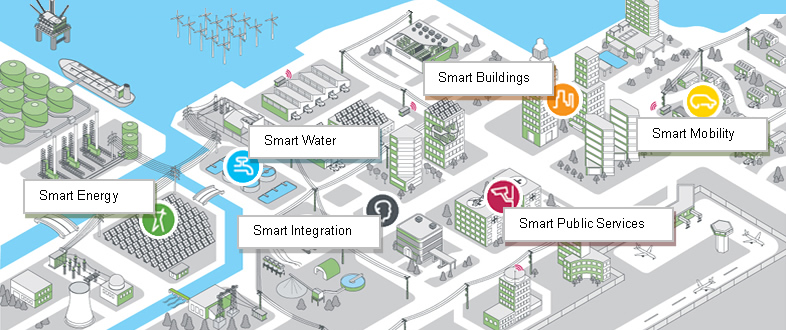
CBR: Define ‘smart city’
Charbel Aoun: A smart city is one that integrates technology into a strategic approach to sustainability, citizen well-being, and economic development. These cities are designed, built, managed and renewed to make them efficient, liveable and sustainable. This is achieved through smart solutions, partner collaboration and innovative technology.
CBR: How large is the addressable market (number of cities)
CA: Estimates of market size vary widely and depend on how the governing centre of a community is counted or combined with other communities in the same metropolitan area.
For example, some large American cities are actually a combination of many cities: if we look at Dallas-Fort Worth, the urban area has a population of 4.1million and the metro area has a population of 6.4million. In practice, Dallas-Fort Worth is made up of 14 jurisdictions having populations ranging from 100k to 1.3million and over 25 smaller districts. Some services extend across multiple communities, and some are managed by communities individually. Some of the communities that can benefit from smart city technology are small enough that they might not necessarily be considered a "city" per se. They might be considered districts or tertiary cities.
The market of cities including primary, secondary and some tertiary may be between 1,500 and 3,000 cities, possibly much greater if tertiary communities in large countries such as China are included.
CBR: Give me three examples of how Schneider Electric technology can make cities smarter
CA: In Dallas, Schneider Electric has been delivering projects for over 10 years. Some of the more recent examples include implementing SCADA technology that increased the efficiency of water distribution across the Dallas region and enabled a faster response to any leaks or disruptions – saving both water and money. We’re also delivering one of the world’s first Integrated Corridor Management systems across the US75 Freeway and Dallas Area Rapid Transit System that will reduce road congestion, increase usage of public transport and provide resiliency to and faster response to accidents and other disruptions as well as making for a safer, greener, more liveable city; and providing energy retrofits across public buildings – creating more efficient and sustainable buildings.
Additionally, Schneider Electric helped the City of Bremen, Germany to reduce its energy spend across 1,200 municipal properties by 15%, using Wonderware to provide a consolidated and optimized city-wide BMS managed from 6 control centres.
CBR: How receptive are UK public sector officials to IOT driven smart city opportunities.
CA: There has been much talk of "big data" and how this provides a wealth of opportunity for cities, businesses and organisations. As a result there has been a lot of exploration around IoT and open data and a strong push to get multiple data sets available for any and all to use. This is valuable work, showing welcome transparency and a willingness to engage with citizens and stakeholders, but may not in itself provide a springboard for developing more efficient, more intelligent cities.
The challenge is how to turn the data into information, then how to use that information to create knowledge, and then finally how you build the knowledge into the fabric of processes and operations to leverage wisdom. It is the knowledge and wisdom that create the opportunities for transformational change, enabling cities to deliver on their vision of the future. It is not enough simply to know!
Cities have to be enabled to act, and this is where operational technology creates empowerment and flexibility for operational teams.
CBR: In general terms where are UK cities on the procurement journey – Exploration? Consulting? Engagement? Procurement?
CA: Cities globally, and within the UK, are in various stages of the customer / procurement journey. The majority have awareness of the smart city topic and in the UK this awareness has deepened over the past 3 years.
Almost every local authority in the UK will have had some dialogue on what a smart city is, and how the concepts, ideas and solutions could be applied within their perimeter. More than a few have developed smart city plans, with a clear vision of where they see their future.
Of these, some are now moving into the Consideration and Selection phases where they are seeking partners to provide solutions to specific, defined opportunities.
UK cities have also been proactive in sharing knowledge and experiences between themselves, and have leveraged support from the BIS (Business, Innovation and Skills) and BSI (British Standards Institute) teams to do so. This peer network greatly helps to develop a common understanding of smart city solutions, benefits and success factors.
CBR: How will SE position/differentiate itself against other global firms tackling the smart cities sector
CA: Smart cities exist at the convergence of citizen engagement, information technology and operational technology. This provides the means for cities to harness technologies in real time to sense, anticipate and respond to emerging city conditions and incidents and adjust systems accordingly. Schneider Electric has a long and successful history of delivering enterprise-critical city infrastructure, including energy supply, water supply, transportation management, public safety, buildings management and data centre management. The breadth of our offering allows us not only to solve problems in a specific vertical, but also to act at the nexus of related systems, for example the energy andwater nexus, or enabling flexible operational teams with common platforms across multiple public services or infrastructure.
CBR: What does the SE Smart City ecosystem look like?
CA: One of the most definitive aspects of a smart city is the ecosystem of players involved: no-one can create the smart city alone. Collaboration is needed across the city departments as well as between governing visionaries, city departments, leading academics and researchers, and best-in-class industry partners. Once this collaboration is put into place the city is better equipped to tackle the challenges of departmental issues (eg. transportation, water, public services) as well as changing urban population needs, environmental concerns and business demands with a holistic view for implementation. This collaboration is essential for smart city success.
CBR: Using your definition above how much would it cost and how long would it take to make London smart?
CA: For any city, large or small, it is critical to have a clear vision and desired outcomes well defined and documented before spending any money on smart city solutions. One city’s vision of what "smart" looks like for them will likely be different to that of another city. With the vision is defined, it become possible to understand where the priorities are for investment and to begin to quantify and prioritise them.
A key point here is that smart cities are a journey, not a destination. Whilst each investment needs to stand on its own in terms of providing a return, it should also be a bridge to new insights or subsequent projects. In the same way that learned people still find new sources of knowledge, learning and insight, cities too are on an ongoing quest for self-improvement.
When it comes to cost, it is not really about spending more but about spending differently. Re-cutting infrastructure budgets makes it possible to invest in projects that drive efficiency and free up more cash in the future. This money can then be re-invested in additional smart city projects.
The cost of moving cities towards their vision of "smart" should not be considered a new and separate time-bound budget, but rather as an ongoing, manageable series of timely and focused investments that cumulatively create a more efficient, liveable and sustainable city for the people, businesses and stakeholders that it holds.






